Family name: Nartheciaceae Fr. ex Bjurzon
Synonym(s): Abaminaceae J. Agardh, nom. illeg.
Common name(s): bog asphodel family
*Number of genera/species: 5/35
List of genera records in GRIN-Global
seed
Fruit a loculicidalloculicidal:
type of capsular dehiscence, opening longitudinally through the locules (compare septicidal)
 capsulecapsule:
capsulecapsule:
a dry, dehiscent fruit derived from a compound ovary , 2–15 mm long, globoseglobose:
, 2–15 mm long, globoseglobose:
3D shape—more or less spherical to conicalconical:
to conicalconical:
3D shape—cone-shaped, with the point of attachment at the broad end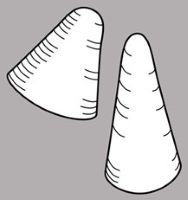 , tereteterete:
, tereteterete:
approximately circular in cross section; width and thickness approximately equal
 or angledangular:
or angledangular:
2D shape—having sides that meet at acute or obtuse angles
in transection, beakedbeak:
a usually firm, terminal appendage, sometimes tapered , perianthperianth:
, perianthperianth:
collective term for calyx and corolla of a flower
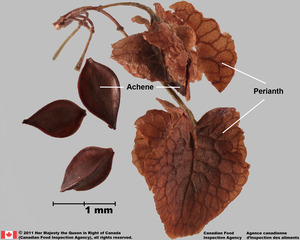 persistent, stylesstyle:
persistent, stylesstyle:
in a flower, the narrow and elongated part of the pistil between the stigma and the ovary; sometimes persisting in fruit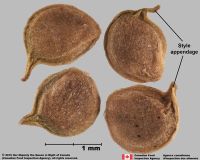 persistent or not, with many seeds. Pericarppericarp:
persistent or not, with many seeds. Pericarppericarp:
fruit wall or fruit coat
green, orange, or reddish brown, chartaceouschartaceous:
papery, papyraceous
, ribbedribbed:
surface relief—wide, prominent, linear ridges that are generally rounded and longitudinally situated on the surface , sometimes pubescentpubescent:
, sometimes pubescentpubescent:
surface relief—bearing hairs
.
Seeds oblongoblong:
2D shape—much longer than broad with nearly parallel sides, corners are rounded to linearlinear:
to linearlinear:
(shape) long, narrow, and uniform in width; (of embryo) embryo is straight and much longer than wide , tereteterete:
, tereteterete:
approximately circular in cross section; width and thickness approximately equal
 in transection, 0.4–11 mm long, often appearing bristle-tailed. Seed coat white or yellow, shinyshiny:
in transection, 0.4–11 mm long, often appearing bristle-tailed. Seed coat white or yellow, shinyshiny:
uniformly reflecting a high proportion of incident light at all angles , deeply sulcatesulcate:
, deeply sulcatesulcate:
surface relief—having one or more elongate, relatively narrow and shallow depressions or grooves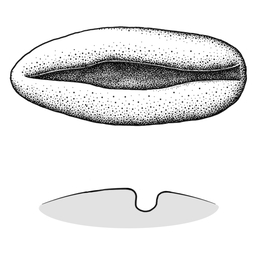 , reticulatereticulate:
, reticulatereticulate:
surface relief—netted, raised walls or concave grooves forming a net-like surface pattern with flat, concave, or convex interspaces or striatestriate:
or striatestriate:
surface relief—having fine, parallel lines, grooves or ridges .
.
Embryo small, globoseglobose:
3D shape—more or less spherical to ovoidovoid:
to ovoidovoid:
3D shape—ovate , straight.
, straight.
Endosperm copious.
| Fruit | |
| Type | capsulecapsule: a dry, dehiscent fruit derived from a compound ovary  |
| Size range | 2–15 mm long |
| Shape(s) | oblongoblong: 2D shape—much longer than broad with nearly parallel sides, corners are rounded  , conicalconical: , conicalconical:3D shape—cone-shaped, with the point of attachment at the broad end  , globoseglobose: , globoseglobose:3D shape—more or less spherical  , ovoidovoid: , ovoidovoid:3D shape—ovate  , lanceoloidlanceoloid: , lanceoloidlanceoloid:3D shape—lanceolate |
| Texture | chartaceouschartaceous: papery, papyraceous |
| Surface relief | ribbedribbed: surface relief—wide, prominent, linear ridges that are generally rounded and longitudinally situated on the surface  , sometimes pubescentpubescent: , sometimes pubescentpubescent:surface relief—bearing hairs |
| Color(s) | green, orange, or reddish brown |
| Unique features | Usually beakedbeak: a usually firm, terminal appendage, sometimes tapered  , chartaceouschartaceous: , chartaceouschartaceous:papery, papyraceous capsulescapsule: a dry, dehiscent fruit derived from a compound ovary  subtended by persistent perianthsperianth: subtended by persistent perianthsperianth:collective term for calyx and corolla of a flower  . . |
| Seed | |
| Size range | 0.4–11 mm long |
| Shape(s) | oblongoblong: 2D shape—much longer than broad with nearly parallel sides, corners are rounded  , ovoidovoid: , ovoidovoid:3D shape—ovate  , ellipsoidellipsoid: , ellipsoidellipsoid:3D shape—elliptic , fusiformfusiform: spindle-shaped; broadest at the middle and tapering at both ends 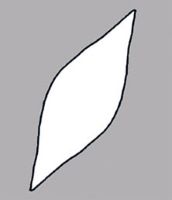 , lanceoloidlanceoloid: , lanceoloidlanceoloid:3D shape—lanceolate , linearlinear: (shape) long, narrow, and uniform in width; (of embryo) embryo is straight and much longer than wide  |
| Surface relief | sulcatesulcate: surface relief—having one or more elongate, relatively narrow and shallow depressions or grooves  and reticulatereticulate: and reticulatereticulate:surface relief—netted, raised walls or concave grooves forming a net-like surface pattern with flat, concave, or convex interspaces  or striatestriate: or striatestriate:surface relief—having fine, parallel lines, grooves or ridges  |
| Color(s) | white, yellow |
| Unique features | Elongate, deeply sulcatesulcate: surface relief—having one or more elongate, relatively narrow and shallow depressions or grooves  , white or yellow seeds, with reticulatereticulate: , white or yellow seeds, with reticulatereticulate:surface relief—netted, raised walls or concave grooves forming a net-like surface pattern with flat, concave, or convex interspaces  or striatestriate: or striatestriate:surface relief—having fine, parallel lines, grooves or ridges  seed coats. seed coats. |
| Other | |
| Embryo | small, globoseglobose: 3D shape—more or less spherical  to ovoidovoid: to ovoidovoid:3D shape—ovate  , straight , straight |
| Nutritive tissue | endosperm copious |
Scattered North temperate distribution, with representatives also in Venezuela, Guiana, and in western Malesia.
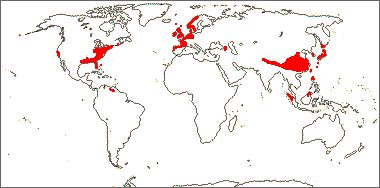
Distribution map courtesy of Angiosperm Phylogeny Website.
Baskin and Baskin 2021Baskin and Baskin 2021:
Baskin C and Baskin J. 2021. Relationship of the lateral embryo (in grasses) to other monocot embryos: A status up-grade. Seed Science Research 31 (3): 199-210. doi:10.1017/S0960258521000209; Dahlgren et al. 1985Dahlgren et al. 1985:
Dahlgren RMT, Clifford HT, and Yeo PF. 1985. The families of the monocotyledons: structure, evolution, and taxonomy. Springer-Verlag, Berlin. 520 pp.; Flora of North America Editorial Committee 1993+Flora of North America Editorial Committee 1993+:
Flora of North America Editorial Committee, eds. 1993+. Flora of North America North of Mexico [Online]. 22+ vols. Flora of North America Association, New York and Oxford. Accessed January-March 2024. URL: http://beta.floranorthamerica.org.; Kirkbride et al. 2006Kirkbride et al. 2006:
Kirkbride JH, Jr, Gunn CR, and Dallwitz MJ. 2006. Family guide for fruits and seeds, vers. 1.0. Accessed September 2020-January 2022. URL: https://nt.ars-grin.gov/seedsfruits/keys/frsdfam/index.cfm .; Kubitzki et al. 1990+Kubitzki et al. 1990+:
Kubitzki K et al., eds. 1990+. The families and genera of vascular plants. 7+ vols. Berlin etc.; Martin 1946Martin 1946:
Martin AC. 1946. The comparative internal morphology of seeds. American Midland Naturalist 36 (3): 513-660. https://doi.org/10.2307/2421457; Tutin et al. 1964–1980Tutin et al. 1964–1980:
Tutin TG, Burges NA, Chater AO, Edmondson JR, Heywood VH, Moore DM, Valentine DH, Walters SM, and Webb DA (eds.) 1964–1980. Flora Europaea. 5 vols. Cambridge University Press, Cambridge UK. 2,524 pp.; Watson and Dallwitz 1992+Watson and Dallwitz 1992+:
Watson L and Dallwitz MJ. 1992+. The families of flowering plants: descriptions, illustrations, identification, and information retrieval. Version: 6th Accessed September 2020-September 2022. URL: delta-intkey.com; Zhengyi et al. 2004+Zhengyi et al. 2004+:
Zhengyi W, Raven PH, and Deyuan H. 2004+. Flora of China [online]. 25 vols. Science Press, Beijing China & Missouri Botanical Garden, St. Louis USA. Accessed January–March 2024. http://flora.huh.harvard.edu/china/
*The number of genera and species is based on Christenhusz and Byng 2016Christenhusz and Byng 2016:
Christenhusz MJM and Byng JW. 2016. The number of known plant species in the world and its annual increase. Phytotaxa 261 (3): 201-217. https://doi.org/10.11646/phytotaxa.261.3.1, which may differ from the number of genera in GRIN-Global.